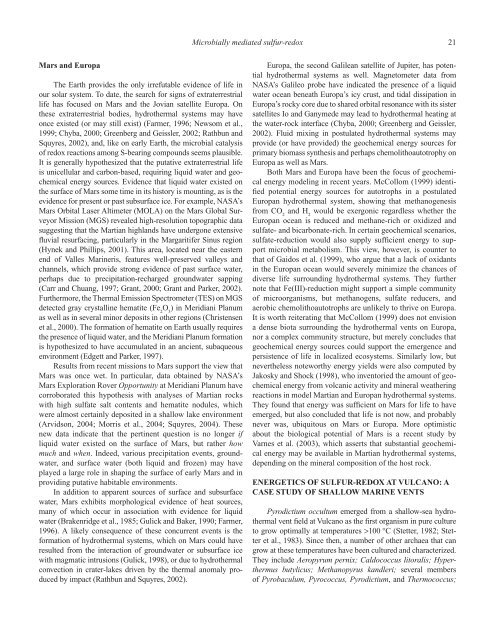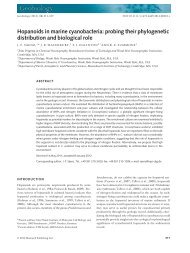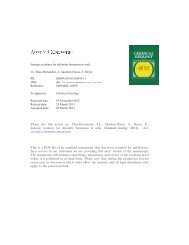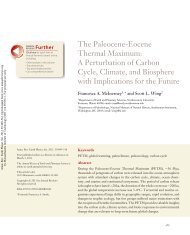Microbially mediated sulfur-redox 21Mars <strong>and</strong> EuropaThe Earth provides the only irrefutable evidence of life inour solar system. To date, the search for signs of extraterrestriallife has focused on Mars <strong>and</strong> the Jovian satellite Europa. Onthese extraterrestrial bodies, hydrothermal systems may haveonce existed (or may still exist) (Farmer, 1996; Newsom et al.,1999; Chyba, 2000; Greenberg <strong>and</strong> Geissler, 2002; Rathbun <strong>and</strong>Squyres, 2002), <strong>and</strong>, like on early Earth, the microbial catalysisof redox reactions among S-bearing compounds seems plausible.It is generally hypothesized that the putative extraterrestrial lifeis unicellular <strong>and</strong> carbon-based, requiring liquid water <strong>and</strong> geochemicalenergy sources. Evidence that liquid water existed onthe surface of Mars some time in its history is mounting, as is theevidence for present or past subsurface ice. For example, NASA’sMars Orbital Laser Altimeter (MOLA) on the Mars Global SurveyorMission (MGS) revealed high-resolution topographic datasuggesting that the Martian highl<strong>and</strong>s have undergone extensivefluvial resurfacing, particularly in the Margaritifer Sinus region(Hynek <strong>and</strong> Phillips, 2001). This area, located near the easternend of Valles Marineris, features well-preserved valleys <strong>and</strong>channels, which provide strong evidence of past surface water,perhaps due to precipitation-recharged groundwater sapping(Carr <strong>and</strong> Chuang, 1997; Grant, 2000; Grant <strong>and</strong> Parker, 2002).Furthermore, the Thermal Emission Spectrometer (TES) on MGSdetected gray crystalline hematite (Fe 2O 3) in Meridiani Planumas well as in several minor deposits in other regions (Christensenet al., 2000). The formation of hematite on Earth usually requiresthe presence of liquid water, <strong>and</strong> the Meridiani Planum formationis hypothesized to have accumulated in an ancient, subaqueousenvironment (Edgett <strong>and</strong> Parker, 1997).Results from recent missions to Mars support the view thatMars was once wet. In particular, data obtained by NASA’sMars Exploration Rover Opportunity at Meridiani Planum havecorroborated this hypothesis with analyses of Martian rockswith high sulfate salt contents <strong>and</strong> hematite nodules, whichwere almost certainly deposited in a shallow lake environment(Arvidson, 2004; Morris et al., 2004; Squyres, 2004). Thesenew data indicate that the pertinent question is no longer ifliquid water existed on the surface of Mars, but rather howmuch <strong>and</strong> when. Indeed, various precipitation events, groundwater,<strong>and</strong> surface water (both liquid <strong>and</strong> frozen) may haveplayed a large role in shaping the surface of early Mars <strong>and</strong> inproviding putative habitable environments.In addition to apparent sources of surface <strong>and</strong> subsurfacewater, Mars exhibits morphological evidence of heat sources,many of which occur in association with evidence for liquidwater (Brakenridge et al., 1985; Gulick <strong>and</strong> Baker, 1990; Farmer,1996). A likely consequence of these concurrent events is theformation of hydrothermal systems, which on Mars could haveresulted from the interaction of groundwater or subsurface icewith magmatic intrusions (Gulick, 1998), or due to hydrothermalconvection in crater-lakes driven by the thermal anomaly producedby impact (Rathbun <strong>and</strong> Squyres, 2002).Europa, the second Galilean satellite of Jupiter, has potentialhydrothermal systems as well. Magnetometer data fromNASA’s Galileo probe have indicated the presence of a liquidwater ocean beneath Europa’s icy crust, <strong>and</strong> tidal dissipation inEuropa’s rocky core due to shared orbital resonance with its sistersatellites Io <strong>and</strong> Ganymede may lead to hydrothermal heating atthe water-rock interface (Chyba, 2000; Greenberg <strong>and</strong> Geissler,2002). Fluid mixing in postulated hydrothermal systems mayprovide (or have provided) the geochemical energy sources forprimary biomass synthesis <strong>and</strong> perhaps chemolithoautotrophy onEuropa as well as Mars.Both Mars <strong>and</strong> Europa have been the focus of geochemicalenergy modeling in recent years. McCollom (1999) identifiedpotential energy sources for autotrophs in a postulatedEuropan hydrothermal system, showing that methanogenesisfrom CO 2<strong>and</strong> H 2would be exergonic regardless whether theEuropan ocean is reduced <strong>and</strong> methane-rich or oxidized <strong>and</strong>sulfate- <strong>and</strong> bicarbonate-rich. In certain geochemical scenarios,sulfate-reduction would also supply sufficient energy to supportmicrobial metabolism. This view, however, is counter tothat of Gaidos et al. (1999), who argue that a lack of oxidantsin the Europan ocean would severely minimize the chances ofdiverse life surrounding hydrothermal systems. They furthernote that Fe(III)-reduction might support a simple communityof microorganisms, but methanogens, sulfate reducers, <strong>and</strong>aerobic chemolithoautotrophs are unlikely to thrive on Europa.It is worth reiterating that McCollom (1999) does not envisiona dense biota surrounding the hydrothermal vents on Europa,nor a complex community structure, but merely concludes thatgeochemical energy sources could support the emergence <strong>and</strong>persistence of life in localized ecosystems. Similarly low, butnevertheless noteworthy energy yields were also computed byJakosky <strong>and</strong> Shock (1998), who inventoried the amount of geochemicalenergy from volcanic activity <strong>and</strong> mineral weatheringreactions in model Martian <strong>and</strong> Europan hydrothermal systems.They found that energy was sufficient on Mars for life to haveemerged, but also concluded that life is not now, <strong>and</strong> probablynever was, ubiquitous on Mars or Europa. More optimisticabout the biological potential of Mars is a recent study byVarnes et al. (2003), which asserts that substantial geochemicalenergy may be available in Martian hydrothermal systems,depending on the mineral composition of the host rock.ENERGETICS OF SULFUR-REDOX AT VULCANO: ACASE STUDY OF SHALLOW MARINE VENTSPyrodictium occultum emerged from a shallow-sea hydrothermalvent field at Vulcano as the first organism in pure cultureto grow optimally at temperatures >100 °C (Stetter, 1982; Stetteret al., 1983). Since then, a number of other archaea that cangrow at these temperatures have been cultured <strong>and</strong> characterized.They include Aeropyrum pernix; Caldococcus litoralis; Hyperthermusbutylicus; Methanopyrus k<strong>and</strong>leri; several membersof Pyrobaculum, Pyrococcus, Pyrodictium, <strong>and</strong> Thermococcus;
22 J.P. Amend, K.L. Rogers, <strong>and</strong> D.R. Meyer-DombardPyrolobus fumarii; Stetteria hydrogenophila; Thermofilum pendens;Thermoproteus uzoniensis; <strong>and</strong> most recently, strain 121with a maximum growth temperature of 121 °C (Stetter et al.,1983; Zillig et al., 1983; Fiala <strong>and</strong> Stetter, 1986; Huber et al.,1987; Svetlitshnyi et al., 1987; Zillig et al., 1987; Huber et al.,1989; Bonch-Osmolovskaya et al., 1990; Zillig et al., 1990; Kurret al., 1991; Pledger <strong>and</strong> Baross, 1991; Pley et al., 1991; Erauso etal., 1993; Völkl et al., 1993; Sako et al., 1996; Blöchl et al., 1997;Jochimsen et al., 1997; Gonzalez et al., 1998; Kashefi <strong>and</strong> Lovley,2003). Like P. occultum, several of these hyperthermophileshail from the hydrothermal seeps <strong>and</strong> vents of Vulcano. In lightof the hyperthermophile diversity documented there—including,by extension, the metabolic diversity—we chose to evaluate theenergetics of a number of redox reactions at in situ geochemicalconditions. We can regard the seeps, wells, <strong>and</strong> vents at Vulcanoas a model system for shallow-sea hydrothermal sites. Othershallow marine vent environments are known off Ambitle <strong>and</strong>Lihir Isl<strong>and</strong>s, Papua New Guinea (Pichler <strong>and</strong> Dix, 1996; Pichleret al., 1999a; Pichler <strong>and</strong> Veizer, 1999; Pichler et al., 1999b);near Milos, Greece (Brinkhoff et al., 1999; Sievert et al., 1999;Stuben <strong>and</strong> Glasby, 1999; Sievert <strong>and</strong> Kuever, 2000; Wenzhoferet al., 2000); at Bahia Concepcion <strong>and</strong> Punta Mita, Mexico (Prol-Ledesma, 2003; Alfonso, et al., 2003); on the Mid-Atlantic KolbeinseyRidge, north of Icel<strong>and</strong> (Burggraf et al., 1990a; Kurr etal., 1991; Botz et al., 1999); <strong>and</strong> near the Aleutian Isl<strong>and</strong>s, Alaska(T. Pichler, 2003, personal commun.), to name only a few.The energetics of 90 chemolithoautotrophic reactions inthe H-O-N-S-C-Fe chemical system at Vulcano are discussed atlength in Amend et al. (2003b); here, we reconsider several ofthe most important S-redox reactions <strong>and</strong> also compute valuesof ∆G rfor chemoorganoheterotrophic reactions in which carboxylicacids serve as the electron donors. Despite the ubiquityof thermophilic heterotrophs, few studies have focused on thecomposition of dissolved organic carbon in hydrothermal systems(Amend et al., 1998). Twenty-five different autotrophic <strong>and</strong>heterotrophic reactions, divided into four groups, are taken intoaccount here: sulfate-reduction, S 0 -reduction <strong>and</strong> -disproportionation,S 0 -oxidation, <strong>and</strong> sulfide-oxidation. Nine of the 25 reactionsare listed twice, once as the forward <strong>and</strong> once as the reversereaction. Consequently, a total of 34 reactions are tabulated. Theamount of energy yielded or consumed by a reaction (∆G r) canbe computed from values of the st<strong>and</strong>ard Gibbs free energy of areaction at the temperature <strong>and</strong> pressure of interest (∆G r°) <strong>and</strong>activities derived from in situ chemical compositions. It shouldbe pointed out that the thermodynamic calculations are based onthe compositions of the mixed hydrothermal solutions <strong>and</strong> not onan end-member vent fluid that gets diluted by ambient seawater.As noted above, the mixing of two chemically distinct aqueoussolutions with sluggish reaction kinetics commonly provides thechemical energy in marine hydrothermal systems, <strong>and</strong> it is in factthis stored energy that we are quantifying. The method to calculate∆G rfor the S-redox reactions is discussed below, but valuesof ∆G r° required in these calculations are obtained from Amend<strong>and</strong> Shock (2001).Known <strong>and</strong> Unknown Microbial S-Redox ReactionsNumerous dissimilatory S-redox processes are known thatprovide metabolic energy to archaea <strong>and</strong> bacteria. A secondgroup of S-redox reactions, which are currently not known to beutilized by any microorganisms, can also be considered. Below,we compute the energetics of both known <strong>and</strong> unknown reactionsunder the geochemical conditions that obtain at Vulcano.An evaluation of the energetics of the second group of reactionsmay aid geomicrobiologists in identifying other potentialmetabolisms <strong>and</strong> in designing culturing protocols to isolate novelS-reducers <strong>and</strong> S-oxidizers.A variety of anaerobes use sulfate or S 0 as a TEA with lowmolecular weight organic compounds or H 2as electron donors. Forexample, members of Archaeoglobus, Desulfotomaculum, Desulfacinum,<strong>and</strong> Thermodesulfobacterium can grow chemolithotrophicallyon H 2plus sulfate; chemolithotrophic S 0 -reduction withH 2as electron donor is carried out, for example, by Pyrodictium,Acidianus, Thermoproteus, Aquifex, Desulfurella, Hyperthermus,<strong>and</strong> Stetteria. In addition, Desulfocapsa <strong>and</strong> Desulfobulbus canharness metabolic energy by disproportionating S 0 . The majorityof sulfate reducers are organotrophs, commonly utilizing carboxylicacids as electron donors. Examples of organisms that oxidizeformic, acetic, or propanoic acid include Desulfovibrio, Desulfotomaculum,Desulfococcus, Desulfobacterium, <strong>and</strong> Archaeoglobus.It has also been shown that anaerobic methane oxidation iscoupled to sulfate-reduction, catalyzed, most likely, by a microbialconsortium that includes a methanogen operating in reverse (as amethanotroph) <strong>and</strong> a sulfate reducer (Hinrichs et al., 1999). Othermicroorganisms couple the oxidation of organic acids to S 0 -reduction;these include members of the Thermoproteales, <strong>Sulfur</strong>ospirillum,Desulfuromonas, Geobacter, <strong>and</strong> Desulfurella.Aerobic as well as anaerobic S-oxidizers thrive in acidic <strong>and</strong>circumneutral waters, both in marine <strong>and</strong> nonmarine ecosystems.For example, members of Thiobacillus, Acidianus, Aquifex, Metallosphaera,Sulfolobus, Sulfobacillus, Beggiatoa, Thiovolum, <strong>and</strong>Thiomicrospira can oxidize H 2S <strong>and</strong>/or S 0 with O 2as the TEA.Further, some members of Thiobacillus, Thioploca, Aquifex, Ferroglobus,<strong>and</strong> Thermothrix gain energy by coupling nitrate-reductionto S-oxidation. However, anaerobic S-oxidation is not limitedto nitrate reducers; members of Thiobacillus, for example, catalyzethe oxidation of S 0 with Fe(III) as the TEA.In addition to known S-redox reactions just highlighted, wealso investigate the energetics of as yet unknown sulfur metabolisms.For example, in the “Sulfate Reduction” section below, wecompute values of ∆G rfor unknown incomplete sulfate-reductionreactions, ones that terminate in S 0 instead of H 2S. In the“Sulfate-Reduction” <strong>and</strong> “S 0 -Reduction <strong>and</strong> S 0 -Disproportionation”sections, we also calculate the energetics of sulfate- <strong>and</strong>S 0 -reduction reactions in which NH 4+<strong>and</strong> Fe 2+ serve as electrondonors. Lastly, unknown S 0 - <strong>and</strong> sulfide-oxidation reactions arediscussed in the “S 0 -Oxidation” <strong>and</strong> “Sulfide-Oxidation” sections,respectively, where we evaluate ∆G rfor reactions withCO 2, NO 3−, <strong>and</strong> Fe(III) as TEAs.
- Page 2: Sulfur Biogeochemistry—Past and P
- Page 8: Preface viisulfurization on the pre
- Page 11 and 12: 2 V. BrüchertThe resulting sulfur
- Page 13 and 14: 4 V. BrüchertFigure 1. Phylogeneti
- Page 15 and 16: 6 V. Brüchertnot yet been resolved
- Page 17 and 18: 8 V. BrüchertEFFECT OF ELECTRON DO
- Page 19 and 20: 10 V. Brüchertfractionation factor
- Page 21 and 22: 12 V. BrüchertFigure 4. Depth prof
- Page 23 and 24: 14 V. Brüchertto derive isotope fr
- Page 25 and 26: 16 V. BrüchertRudnicki, M.D., Elde
- Page 28 and 29: Microbially mediated sulfur-redox 1
- Page 32 and 33: Microbially mediated sulfur-redox 2
- Page 34 and 35: Microbially mediated sulfur-redox 2
- Page 36 and 37: Microbially mediated sulfur-redox 2
- Page 38 and 39: Microbially mediated sulfur-redox 2
- Page 40 and 41: Microbially mediated sulfur-redox 3
- Page 42 and 43: Microbially mediated sulfur-redox 3
- Page 44 and 45: Geological Society of AmericaSpecia
- Page 46 and 47: Eukaryotes of the Cariaco, Soledad,
- Page 48 and 49: Eukaryotes of the Cariaco, Soledad,
- Page 50 and 51: Eukaryotes of the Cariaco, Soledad,
- Page 52 and 53: Eukaryotes of the Cariaco, Soledad,
- Page 54 and 55: Eukaryotes of the Cariaco, Soledad,
- Page 56: Eukaryotes of the Cariaco, Soledad,
- Page 59 and 60: 50 A. SchippersTABLE 1. DETECTION O
- Page 61 and 62: 52 A. SchippersS 4O 62−+ H 2O →
- Page 63 and 64: 54 A. Schippersthe oxygen molecule
- Page 65 and 66: 56 A. Schippersprohibits biological
- Page 67 and 68: 58 A. SchippersSampleTABLE 4. SULFU
- Page 69 and 70: 60 A. SchippersGeochimica et Cosmoc
- Page 71 and 72: 62 A. SchippersSasaki, K., Tsunekaw
- Page 73 and 74: 64 B.B. Jørgensen and D.C. NelsonI
- Page 75 and 76: 66 B.B. Jørgensen and D.C. NelsonF
- Page 77 and 78: 68 B.B. Jørgensen and D.C. Nelsonq
- Page 79 and 80: 70 B.B. Jørgensen and D.C. Nelsons
- Page 81 and 82:
72 B.B. Jørgensen and D.C. Nelsonp
- Page 83 and 84:
74 B.B. Jørgensen and D.C. NelsonP
- Page 85 and 86:
76 B.B. Jørgensen and D.C. Nelsont
- Page 87 and 88:
78 B.B. Jørgensen and D.C. NelsonF
- Page 89 and 90:
80 B.B. Jørgensen and D.C. NelsonJ
- Page 92 and 93:
Geological Society of AmericaSpecia
- Page 94 and 95:
Formation and degradation of seafl
- Page 96 and 97:
Formation and degradation of seafl
- Page 98 and 99:
Formation and degradation of seafl
- Page 100 and 101:
Formation and degradation of seafl
- Page 102 and 103:
Formation and degradation of seafl
- Page 104 and 105:
Formation and degradation of seafl
- Page 106 and 107:
Geological Society of AmericaSpecia
- Page 108 and 109:
Distribution and fate of sulfur int
- Page 110 and 111:
Distribution and fate of sulfur int
- Page 112 and 113:
Distribution and fate of sulfur int
- Page 114 and 115:
Distribution and fate of sulfur int
- Page 116 and 117:
Distribution and fate of sulfur int
- Page 118 and 119:
Distribution and fate of sulfur int
- Page 120 and 121:
Distribution and fate of sulfur int
- Page 122 and 123:
Distribution and fate of sulfur int
- Page 124 and 125:
Distribution and fate of sulfur int
- Page 126 and 127:
Geological Society of AmericaSpecia
- Page 128 and 129:
- HSO 4SO 2-4H 2 SCO 32-HCO 3-HCO 3
- Page 130 and 131:
Sedimentary pyrite formation 121mar
- Page 132 and 133:
Sedimentary pyrite formation 123The
- Page 134 and 135:
Sedimentary pyrite formation 125Ben
- Page 136 and 137:
Sedimentary pyrite formation 127TAB
- Page 138 and 139:
Sedimentary pyrite formation 129The
- Page 140 and 141:
Sedimentary pyrite formation 131Dek
- Page 142 and 143:
Sedimentary pyrite formation 133Mor
- Page 144 and 145:
Geological Society of AmericaSpecia
- Page 146 and 147:
Recent advances and future research
- Page 148 and 149:
Recent advances and future research
- Page 150 and 151:
Recent advances and future research
- Page 152 and 153:
Recent advances and future research
- Page 154 and 155:
Recent advances and future research
- Page 156 and 157:
Recent advances and future research
- Page 158 and 159:
Recent advances and future research
- Page 160 and 161:
Geological Society of AmericaSpecia
- Page 162 and 163:
Using sulfur isotopes to elucidate
- Page 164 and 165:
Using sulfur isotopes to elucidate
- Page 166 and 167:
Using sulfur isotopes to elucidate
- Page 168 and 169:
Using sulfur isotopes to elucidate
- Page 170 and 171:
Geological Society of AmericaSpecia
- Page 172 and 173:
Sites of anomalous organic reminera
- Page 174 and 175:
Sites of anomalous organic reminera
- Page 176 and 177:
Sites of anomalous organic reminera
- Page 178 and 179:
Sites of anomalous organic reminera
- Page 180 and 181:
Sites of anomalous organic reminera
- Page 182 and 183:
Sites of anomalous organic reminera
- Page 184 and 185:
Sites of anomalous organic reminera
- Page 186 and 187:
Geological Society of AmericaSpecia
- Page 188 and 189:
Sulfur isotope composition of carbo
- Page 190 and 191:
Sulfur isotope composition of carbo
- Page 192 and 193:
Sulfur isotope composition of carbo
- Page 194 and 195:
Sulfur isotope composition of carbo
- Page 196 and 197:
Sulfur isotope composition of carbo
- Page 198 and 199:
Sulfur isotope composition of carbo
- Page 200 and 201:
Sulfur isotope composition of carbo
- Page 202 and 203:
Sulfur isotope composition of carbo
- Page 204 and 205:
Geological Society of AmericaSpecia
- Page 206 and 207:
4 Ga of seawater evolution 197brine
- Page 208 and 209:
4 Ga of seawater evolution 199Figur
- Page 210 and 211:
4 Ga of seawater evolution 201data
- Page 212 and 213:
4 Ga of seawater evolution 203notab
- Page 214:
4 Ga of seawater evolution 205et Co







